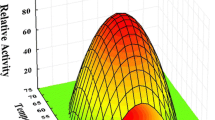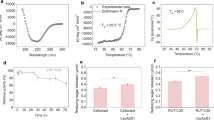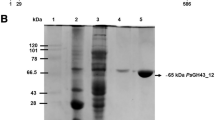Abstract
An α-l-arabinofuranosidase of GH62 from Aspergillus nidulans FGSC A4 (AnAbf62A-m2,3) has an unusually high activity towards wheat arabinoxylan (WAX) (67 U/mg; k cat = 178/s, K m = 4.90 mg/ml) and arabinoxylooligosaccharides (AXOS) with degrees of polymerisation (DP) 3–5 (37–80 U/mg), but about 50 times lower activity for sugar beet arabinan and 4-nitrophenyl-α-l-arabinofuranoside. α-1,2- and α-1,3-linked arabinofuranoses are released from monosubstituted, but not from disubstituted, xylose in WAX and different AXOS as demonstrated by NMR and polysaccharide analysis by carbohydrate gel electrophoresis (PACE). Mutants of the predicted general acid (Glu188) and base (Asp28) catalysts, and the general acid pK a modulator (Asp136) lost 1700-, 165- and 130-fold activities for WAX. WAX, oat spelt xylan, birchwood xylan and barley β-glucan retarded migration of AnAbf62A-m2,3 in affinity electrophoresis (AE) although the latter two are neither substrates nor inhibitors. Trp23 and Tyr44, situated about 30 Å from the catalytic site as seen in an AnAbf62A-m2,3 homology model generated using Streptomyces thermoviolaceus SthAbf62A as template, participate in carbohydrate binding. Compared to wild-type, W23A and W23A/Y44A mutants are less retarded in AE, maintain about 70 % activity towards WAX with K i of WAX substrate inhibition increasing 4–7-folds, but lost 77–96 % activity for the AXOS. The Y44A single mutant had less effect, suggesting Trp23 is a key determinant. AnAbf62A-m2,3 seems to apply different polysaccharide-dependent binding modes, and Trp23 and Tyr44 belong to a putative surface binding site which is situated at a distance of the active site and has to be occupied to achieve full activity.






Similar content being viewed by others
References
Barkholt V, Jensen AL (1989) Amino acid analysis: determination of cysteine plus half-cystine in proteins after hydrochloric acid hydrolysis with a disulfide compound as additive. Anal Biochem 177:318–322. doi:10.1016/0003-2697(89)90059-6
Bauer S, Vasu P, Persson S, Mort AJ, Somerville CR (2006) Development and application of a suite of polysaccharide-degrading enzymes for analyzing plant cell walls. Proc Natl Acad Sci U S A 103:11417–11422. doi:10.1073/pnas.0604632103
Bowman MJ, Dien BS, Vermillion KE, Mertens JA (2015) Isolation and characterization of unhydrolyzed oligosaccharides from switchgrass (Panicum virgatum, L.) xylan after exhaustive enzymatic treatment with commercial enzyme preparations. Carbohydr Res 407:42–50. doi:10.1016/j.carres.2015.01.018
Britton HTS, Robinson RA (1931) Universal buffer solutions and the dissociation constant of veronal. J Chem Soc 1456–1462. doi:10.1039/jr9310001456
Bromley JR, Busse-Wicher M, Tryfona T, Mortimer JC, Zhang Z, Brown DM, Dupree P (2013) GUX1 and GUX2 glucuronyltransferases decorate distinct domains of glucuronoxylan with different substitution patterns. Plant J 74:423–434. doi:10.1111/tpj.12135
Buchan DWA, Ward SM, Lobley AE, Nugent TCO, Bryson K, Jones DT (2010) Protein annotation and modelling servers at University College London. Nucleic Acids Res 38:563–568. doi:10.1093/nar/gkq427
Busk PK, Lange L (2013) Function-based classification of carbohydrate-active enzymes by recognition of short, conserved peptide motifs. Appl Environ Microbiol 79:3380–3391. doi:10.1128/AEM.03803-12
Couturier M, Haon M, Coutinho PM, Henrissat B, Lesage-Meessen L, Berrin J-G (2011) Podospora anserina hemicellulases potentiate the Trichoderma reesei secretome for saccharification of lignocellulosic biomass. Appl Environ Microbiol 77:237–246. doi:10.1128/AEM.01761-10
Cuyvers S, Dornez E, Rezaei MN, Pollet A, Delcour JA, Courtin CM (2011) Secondary substrate binding strongly affects activity and binding affinity of Bacillus subtilis and Aspergillus niger GH11 xylanases. FEBS J 278:1098–1111. doi:10.1111/j.1742-4658.2011.08023.x
De La Mare M, Guais O, Bonnin E, Weber J, Francois JM (2013) Molecular and biochemical characterization of three GH62 α-l-arabinofuranosidases from the soil deuteromycete Penicillium funiculosum. Enzym Microb Technol 53:351–358. doi:10.1016/j.enzmictec.2013.07.008
De Vos D, Collins T, Nerinckx W, Savvides SN, Claeyssens M, Gerday C, Feller G, Van Beeumen J (2006) Oligosaccharide binding in family 8 glycosidases: crystal structures of active-site mutants of the β-1,4-xylanase pXyl from Pseudoaltermonas haloplanktis TAH3a in complex with substrate and product. Biochemistry 45:4797–4807. doi:10.1021/bi052193e
Emanuelsson O, Brunak S, von Heijne G, Nielsen H (2007) Locating proteins in the cell using TargetP, SignalP and related tools. Nat Protoc 2:953–971. doi:10.1038/nprot.2007.131
Goubet F, Jackson P, Deery MJ, Dupree P (2002) Polysaccharide analysis using carbohydrate gel electrophoresis: a method to study plant cell wall polysaccharides and polysaccharide hydrolases. Anal Biochem 300:53–68. doi:10.1006/abio.2001.5444
Hashimoto K, Yoshida M, Hasumi K (2011) Isolation and characterization of CcAbf62A, a GH62 α-l-arabinofuranosidase, from the Basidiomycete Coprinopsis cinerea. Biosci Biotechnol Biochem 75:342–345. doi:10.1271/bbb.100434
Jordan DB, Bowman MJ, Braker JD, Dien BS, Hector RE, Lee CC, Mertens JA, Wagschal K (2012) Plant cell walls to ethanol. Biochem J 442:241–252. doi:10.1042/BJ20111922
Kaur AP, Nocek BP, Xu X, Lowden MJ, Leyva JF, Stogios PJ, Cui H, Di Leo R, Powlowski J, Tsang A, Savchenko A (2014) Functional and structural diversity in GH62 α-l-arabinofuranosidases from the thermophilic fungus Scytalidium thermophilum. Microbiol Biotechnol 8:419–433. doi:10.1111/1751-7915.12168
Kellett LE, Poole DM, Ferreira LM, Durrant AJ, Hazlewood GP, Gilbert HJ (1990) Xylanase B and an arabinofuranosidase from Pseudomonas fluorescens subsp. cellulosa contain identical cellulose-binding domains and are encoded by adjacent genes. Biochem J 272:369–376
Kimura I, Yoshioka N, Kimura Y, Tajima S (2000) Cloning, sequencing and expression of an α-l-arabinofuranosidase from Aspergillus sojae. J Biosci Bioeng 89:262–266
Kormelink FJM, Voragen AGJ (1993) Degradation of different [(glucurono)arabinoxylans by a combination of purified xylan-degrading enzymes. Appl Microbiol Biotechnol 38:688–695. doi:10.1007/BF00182811
Lange L, Sørensen HR, Hamann T (2006) New Penicillium arabinofuranosidase, used in dough and useful ethanol process, mashing process, and for producing feed composition. WO2006/125438-A1
Li K, Azadi P, Collins R, Tolan J, Kim JS, Eriksson K-L (2000) Relationship between activities of xylanases and xylan structures. Enzyme Microb Technol 27:89–94. doi:10.1016/S0141-0229(00)00190-3
Li W, Cowley A, Uludag M, Gur T, McWilliam H, Squizzato S, Park YM, Buso N, Lopez R (2015) The EMBL-EBI bioinformatics web and programmatic tools framework. Nucleic Acids Res 43:580–584. doi:10.1093/nar/gkv279
Lombard V, Golaconda Ramulu H, Drula E, Coutinho PM, Henrissat B (2014) The carbohydrate-active enzymes database (CAZy) in 2013. Nucleic Acids Res 42:D490–D495. doi:10.1093/nar/gkt1178
Ludwiczek ML, Heller M, Kantner T, McIntosh LP (2007) A secondary xylan-binding site enhances the catalytic activity of a single-domain family 11 glycoside hydrolase. J Mol Biol 373:337–354. doi:10.1016/j.jmb.2007.07.057
Maehara T, Fujimoto Z, Ichinose H, Michikawa M, Harazono K, Kaneko S (2014) Crystal structure and characterization of the glycoside hydrolase family 62 α-l-arabinofuranosidase from Streptomyces coelicolor. J Biol Chem 289:7962–7972. doi:10.1074/jbc.M113.540542
Marchler-Bauer A, Lu S (2011) CDD: a Conserved Domain Database for the functional annotation of proteins. Nucleic Acids Res 39:D225–D229. doi:10.1093/nar/gkq1189
Margolles-Clark E, Tenkanen M, Nakari-Setälä T, Penttilä M (1996) Cloning of genes encoding α-l-arabinofuranosidase and β-xylosidase from Trichoderma reesei by expression in Saccharomyces cerevisiae. Appl Environ Microbiol 62:3840–3846
McCleary BV, McKie VA, Draga A, Rooney E, Mangan D, Larkin J (2015) Hydrolysis of wheat flour arabinoxylan, acid-debranched wheat flour arabinoxylan and arabino-xylo-oligosaccharides by β-xylanase, α-l-arabinofuranosidase and β-xylosidase. Carbohydr Res 407:79–96. doi:10.1016/j.carres.2015.01.017
McKee LS, Peña MJ, Rogowski A, Jackson A, Lewis RJ, York WS, Krogh KBRM, Viksø-Nielsen A, Skjøt M, Gilbert HJ, Marles-Wright J (2012) Introducing endo-xylanase activity into an exo-acting arabinofuranosidase that targets side chains. Proc Natl Acad Sci U S A 109:6537–6542. doi:10.1073/pnas.1117686109
McKie VA, Black GW, Millward-Sadler SJ, Hazlewood GP, Laurie JI, Gilbert HJ (1997) Arabinase A from Pseudomonas fluorescens subsp. cellulosa exhibits both an endo- and an exo- mode of action. Biochem J 555:547–555. doi:10.1042/bj3230547
Mohun AF, Cook IJ (1962) An improved dinitrosalicylic acid method for determining blood and cerebrospinal fluid sugar levels. J Clin Pathol 15:169–180. doi:10.1136/jcp.15.2.169
Nielsen JW, Kramhøft B, Bozonnet S, Abou Hachem M, Stipp SLS, Svensson B, Willemoës M (2012) Degradation of the starch components amylopectin and amylose by barley α-amylase 1: role of surface binding site 2. Arch Biochem Biophys 528:1–6. doi:10.1016/j.abb.2012.08.005
Numan MT, Bhosle NB (2006) α-l-arabinofuranosidases: the potential applications in biotechnology. J Ind Microbiol Biotechnol 33:247–260. doi:10.1007/s10295-005-0072-1
Nurizzo D, Turkenburg JP, Charnock SJ, Roberts SM, Dodson EJ, McKie VA, Taylor EJ, Gilbert HJ, Davies GJ (2002) Cellvibrio japonicus α-l-arabinanase 43A has a novel five-blade beta-propeller fold. Nat Struct Biol 9:665–668. doi:10.1038/nsb835
Oudjeriouat N, Moreau Y, Santimone M, Svensson B, Marchis-Mouren G, Desseaux V (2003) On the mechanism of α-amylase. Eur J Biochem 270:3871–3879. doi:10.1046/j.1432-1033.2003.03733.x
Pitkänen L, Virkki L, Tenkanen M, Tuomainen P (2009) Comprehensive multidetector HPSEC study on solution properties of cereal arabinoxylans in aqueous and DMSO solutions. Biomacromolecules 10:1962–1969. doi:10.1021/bm9003767
Pitson SM, Voragen AG, Beldman G (1996) Stereochemical course of hydrolysis catalyzed by arabinofuranosyl hydrolases. FEBS Lett 398:7–11. doi:10.1016/S0014-5793(96)01153-2
Poutanen K (1988) An α-l-arabinofuranosidase of Trichoderma reesei. J Biotechnol 7:271–281. doi:10.1016/0168-1656(88)90039-9
Ransom RF, Walton JD (1997) Purification and characterization of extracellular β-xylosidase and α-arabinosidase from the plant pathogenic fungus Cochliobolus carbonum. Carbohydr Res 297:357–364. doi:10.1016/S0008-6215(96)00281-9
Sakamoto T, Ogura A, Inui M, Tokuda S, Hosokawa S, Ihara H, Kasai N (2011) Identification of a GH62 α-l-arabinofuranosidase specific for arabinoxylan produced by Penicillium chrysogenum. Appl Microbiol Biotechnol 90:137–146. doi:10.1007/s00253-010-2988-2
Sakamoto T, Inui M, Yasui K, Hosokawa S, Ihara H (2013) Substrate specificity and gene expression of two Penicillium chrysogenum α-l-arabinofuranosidases (AFQ1 and AFS1) belonging to glycoside hydrolase families 51 and 54. Appl Microbiol Biotechnol 97:1121–1130. doi:10.1007/s00253-012-3978-3
Schmidt A, Gu GM, Kratky C (1999) Xylan binding subsite mapping in the xylanase from Penicillium simplicissimum using xylooligosaccharides as cryo-protectant. Biochemistry 38:2403–2412. doi:10.1021/bi982108l
Siguier B, Haon M, Nahoum V, Marcellin M, Burlet-Schiltz O, Coutinho PM, Henrissat B, Mourey L, O Donohue MJ, Berrin J-G, Tranier S, Dumon C (2014) First structural insights into α-L-arabinofuranosidases from the two GH62 glycoside hydrolase subfamilies. J Biol Chem 289:5261–5273. doi:10.1074/jbc.M113.528133
Söding J, Biegert A, Lupas AN (2005) The HHpred interactive server for protein homology detection and structure prediction. Nucleic Acids Res 33:244–248. doi:10.1093/nar/gki408
Tamura K, Stecher G, Peterson D, Filipski A, Kumar S (2013) MEGA6: Molecular evolutionary genetics analysis version 6.0. Mol Biol Evol 30:2725–2729. doi:10.1093/molbev/mst197
Tsujibo H, Takada C, Wakamatsu Y, Kosaka M, Tsuji A, Miyamoto K, Inamori Y (2002) Cloning and expression of an α-l-arabinofuranosidase gene (stxIV) from Streptomyces thermoviolaceus OPC-520, and characterization of the enzyme. Biosci Biotechnol Biochem 66:434–438. doi:10.1271/bbb.66.434
Van Laere KMJ, Voragen CHL, Kroef T, Van den Broek LAM, Beldman G, Vorage PO (1999) Purification and mode of action of two different arabinoxylan arabinofuranohydrolases from Bifidobacterium adolescentis DSM 20083. Appl Microbiol Biotechnol 51:606–613. doi:10.1007/s002530051439
Vandermarliere E, Bourgois TM, Rombouts S, Van Campenhout S, Volckaert G, Strelkov SV, Delcour JA, Rabijns A, Courtin CM (2008) Crystallographic analysis shows substrate binding at the −3 to +1 active-site subsites and at the surface of glycoside hydrolase family 11 endo-1,4-β-xylanases. Biochem J 410:71–79. doi:10.1042/BJ20071128
Vardakou M, Dumon C, Murray JW, Christakopoulos P, Weiner DP, Juge N, Lewis RJ, Gilbert HJ, Flint JE (2008) Understanding the structural basis for substrate and inhibitor recognition in eukaryotic GH11 xylanases. J Mol Biol 375:1293–1305. doi:10.1016/j.jmb.2007.11.007
Vincent P, Shareck F, Dupont C, Morosoli R, Kluepfel D (1997) New α-l-arabinofuranosidase produced by Streptomyces lividans: cloning and DNA sequence of the abfB gene and characterization of the enzyme 852:845–852. doi: 10.1042/bj3220845
Wallner B, Elofsson A (2003) Can correct protein models be identified? Protein Sci 12:1073–1086. doi:10.1110/ps.0236803.a
Wang W, Mai-Gisondi G, Stogios PJ, Kaur A, Xu X, Cui H, Turunen O, Savchenko A, Master ER (2014) Elucidation of the molecular basis for arabinoxylan-debranching activity of a thermostable family GH62 α-l-arabinofuranosidase from Streptomyces thermoviolaceus. Appl Environ Microbiol 80:5317–5329. doi:10.1128/AEM.00685-14
Acknowledgments
Mette Pries is thanked for technical assistance and Anne Blicher for amino acid analysis. The 800 MHz NMR spectra were recorded at the Danish National Instrument Centre for NMR spectroscopy of Biological Macromolecules at the Carlsberg Laboratory. Maja Tenkanen (University of Helsinki) is thanked for doubly substituted AXOS.
Author information
Authors and Affiliations
Corresponding author
Ethics declarations
This article does not contain any studies with human participants or animals performed by any of the authors.
Funding
This work is supported by the Danish Council for Independent Research|Natural Sciences (FNU) [grant number 09-072151], by 1/3 PhD fellowship from the Technical University of Denmark (to CW) and by a Hans Christian Ørsted postdoctoral fellowship from DTU (to DC).
Conflict of interest
Barry McCleary is the CEO and founder of Megazyme International.
Electronic supplementary material
ESM 1
(PDF 923 kb)
Rights and permissions
About this article
Cite this article
Wilkens, C., Andersen, S., Petersen, B.O. et al. An efficient arabinoxylan-debranching α-l-arabinofuranosidase of family GH62 from Aspergillus nidulans contains a secondary carbohydrate binding site. Appl Microbiol Biotechnol 100, 6265–6277 (2016). https://doi.org/10.1007/s00253-016-7417-8
Received:
Revised:
Accepted:
Published:
Issue Date:
DOI: https://doi.org/10.1007/s00253-016-7417-8




